Safe Mode Windows 10: What It Is & How to Use It to Your Advantage
Your computer freezes, crashes, or will not start as it should, and you are left wondering what went wrong. When problems like this happen, one of the best tools at your fingertips is Safe Mode Windows 10. It starts your system with only the core features needed to run, giving you a clean environment to fix issues without extra apps or settings getting in the way. Whether it is a failed update, a virus, or a stubborn program, safe mode helps you get back on track quickly and safely.

In this article:
Part 1: What is Windows 10 Safe Mode
Windows 10 Safe Mode is a notable startup mode that loads your operating system with only the basic files and drivers it needs to run. It is designed to help you troubleshoot problems by stripping away non-essential programs, background services, and startup apps that could be causing errors, conflicts, or Windows stuck on the loading screen.
Windows runs with minimal features in this mode - no flashy graphics, no network access unless you choose Safe Mode with Networking, and no third-party software. This clean environment makes finding and fixing issues like faulty drivers, corrupted files, or malware easier.
If your computer crashes often or refuses to start normally, using Safe Mode gives you a better chance to identify the problem and get your system back on track. There are three major types of Safe Mode you can pick from, depending on what you need:
• Safe Mode: The basic version that runs Windows with only the most essential system files and drivers. Best for general troubleshooting.
• Safe Mode with Networking: This mode includes the same features as regular Safe Mode but adds network drivers and services. It is useful if you need to access the Internet or files on other computers while fixing your system.
• Safe Mode with Command Prompt: This choice replaces the usual desktop interface with the Command Prompt window. IT professionals and advanced users prefer this option for running manual system repair commands.
Part 2: How to Boot into Safe Mode Windows 10 Without Login
Sometimes, your computer will not let you log in, but you must fix a problem. Many users ask how to boot into Safe Mode in Windows 10 without a password. Safe Mode is a useful way to solve issues like system errors or crashes, but it can be hard to access if locked out.
imyPass Windows Password Reset is a tool that can help. It lets you enter Safe Mode without logging in. It is easy to use, does not delete your files, and has a 100 percent success rate. You can access your system, fix the problem, and keep your data safe with just a few actions. This tool is a great choice if you need a quick and simple way to use Safe Mode.
Start by using a working computer to download imyPass Windows Password Reset. Since your main PC is locked, this second device will create the necessary bootable reset tool.
Plug in a blank USB flash drive or CD/DVD. Launch imyPass, then follow the on-screen steps to create a bootable reset disk. This disk will unlock your Windows 10 device and access Safe Mode.
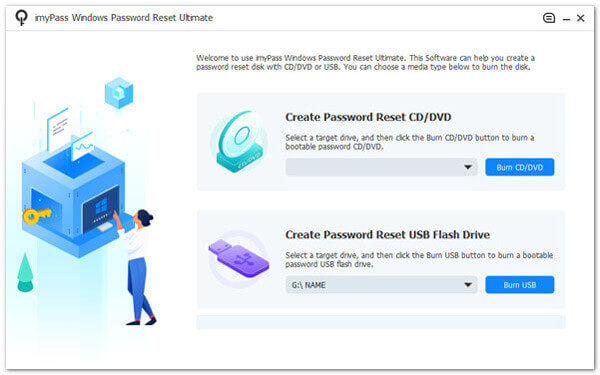
Insert the newly created reset disk into the locked computer. Restart the PC and press the Boot Menu key, usually F12, ESC, or F9 - varies by brand as it powers on. Choose the USB or CD/DVD option from the list so your computer boots directly from the reset disk.
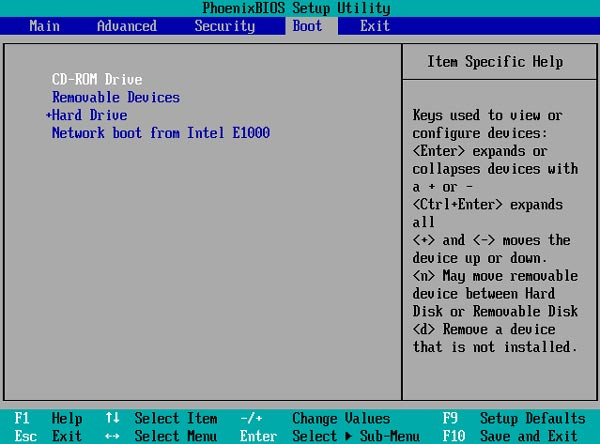
Select your Windows version from the options once imyPass loads on the locked PC. Then choose the user account you want to unlock and click Reset Password. The tool will remove or reset the password so you can access your system again.
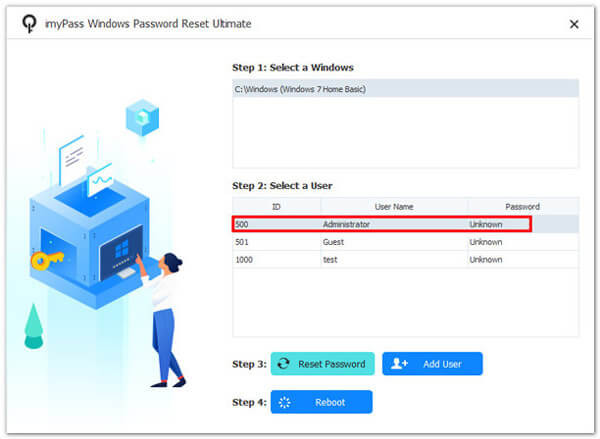
After the password reset is done, click Reboot. Remove the USB or CD/DVD so your PC boots normally. You will now be able to log in without entering a password. With that, you can bypass the password on Windows Safe Mode.
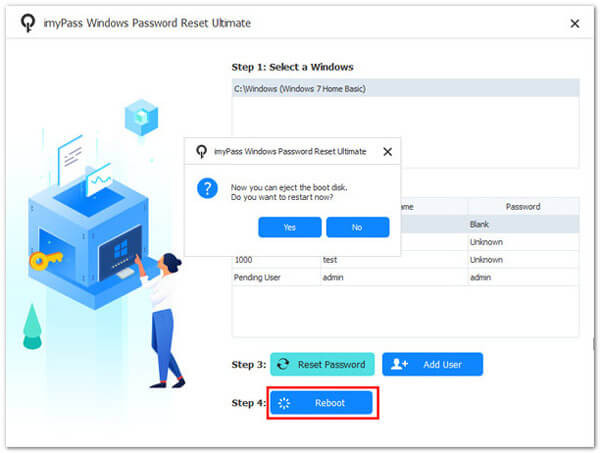
Part 3: How to Start Windows 10 in Safe Mode
If your computer is acting up or not running as it should, starting in Safe Mode can help you fix the problem. Safe Mode runs Windows with only the basic files and drivers, making finding and solving errors easier. Learning how to start Windows 10 safely is useful, whether you are dealing with software issues, slow performance, or driver conflicts.
Go to Start, select Settings, then click Update & Security.
In the sidebar, choose Recovery. Under Advanced Startup, click Restart now to reboot into Advanced Startup mode.
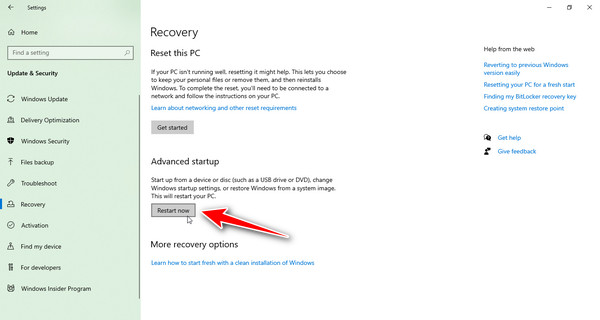
After restarting, go to Troubleshoot > Advanced options > Startup Settings, then click Restart again.
Once your PC restarts, you will notice a list of options. Press F4 to start Windows 10 OS in Safe Mode.
When you are in Safe Mode, you can check for any problems since background apps and drivers will not be active. Whatever action you need to take, like uninstalling malware, returning to a previous update or dealing with startup problems, Safe Mode is your safest choice. Starting Windows 10 in Safe Mode gives you greater confidence in handling most issues on your computer.
Part 4: How to Turn off Windows 10 Safe Mode
After troubleshooting, you should return your system to normal mode. Some users get stuck in Safe Mode and wonder how to exit it properly. If your Windows 10 boots into safe mode each time you restart, here is how to turn it off correctly.
Press Windows + R to open Run, type msconfig, and press Enter. This opens the System Configuration window.
Check if the Safe Boot option is selected under Boot options in the Boot section. Remove the checkmark next to Safe boot. Click Apply, then click OK.
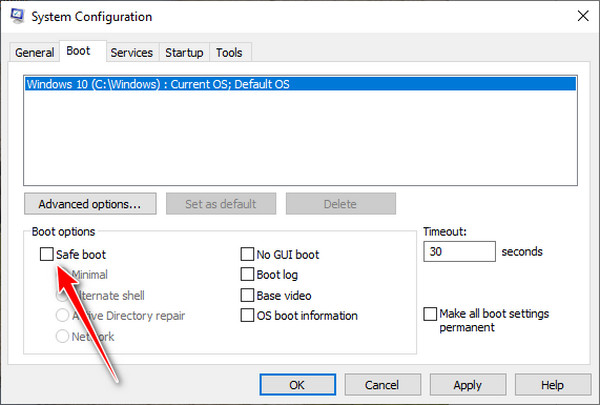
Restart your PC to boot normally. It should now start in standard mode instead of Safe Mode.
You should care about how you leave Safe Mode just as much as how you enter it. Setting Safe Boot to Off in System Configuration will let your computer start as usual. That way, all apps, features, and drivers start working as usual. You can use your PC normally again when you have resolved your problems in Safe Mode.
Conclusion
Knowing how to enter safe mode in Windows 10 helps you fix many common problems. Running your computer in Safe Mode uses only basic files, which makes troubleshooting problems easier. Keeping your PC healthy is easy if you know how to start and exit Safe Mode. You can easily access Safe Mode upon being locked out by using the imyPass software. Adopting these easy methods helps you protect your computer.
Hot Solutions
-
Windows Tips
-
Windows Password
-
Fix Windows
-
Password Tips

